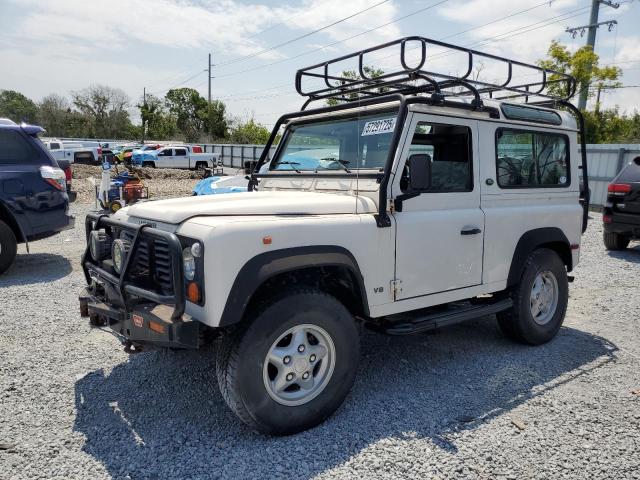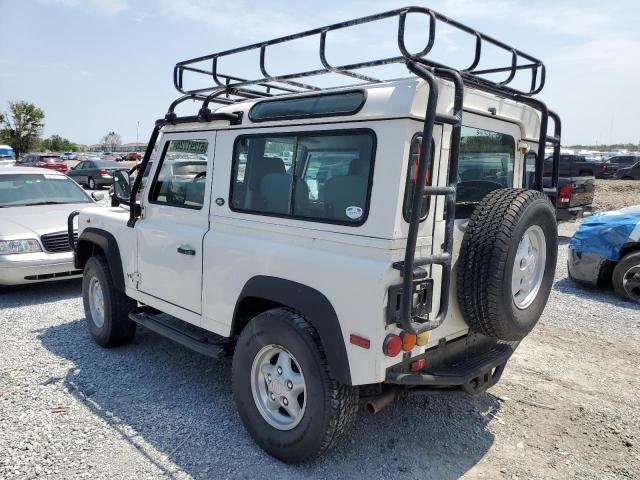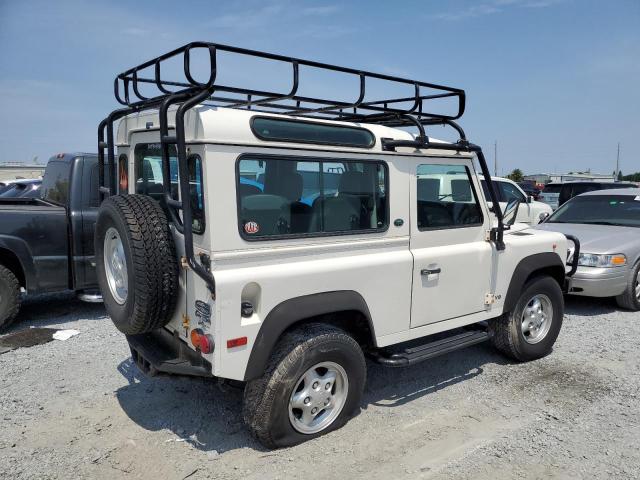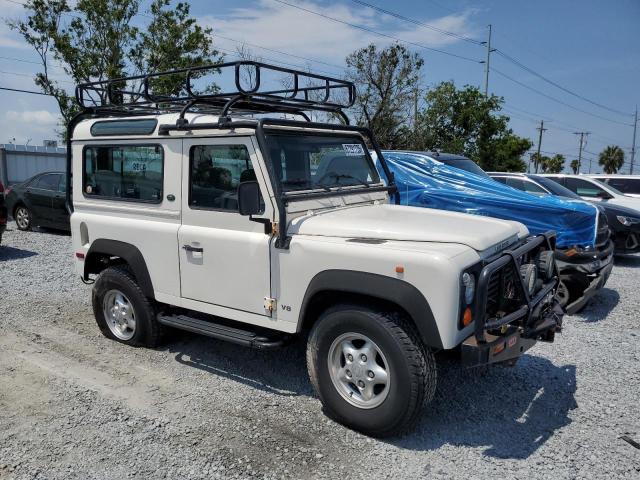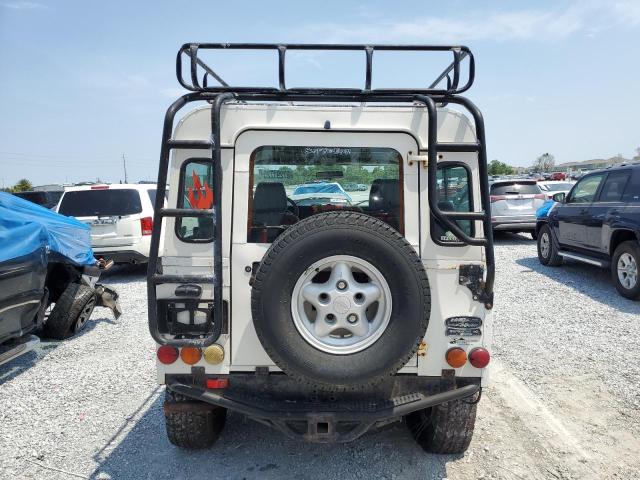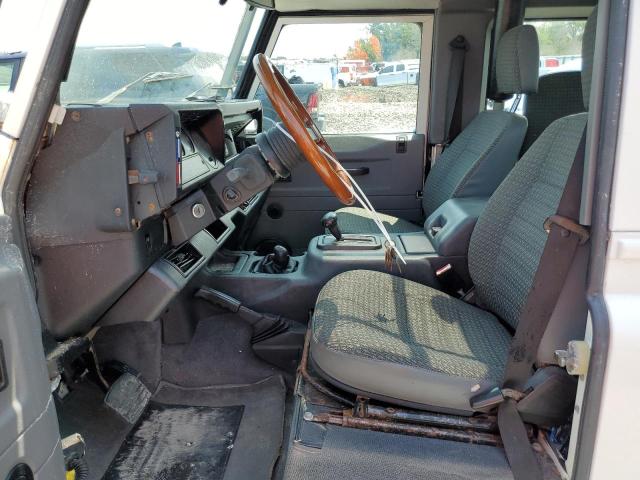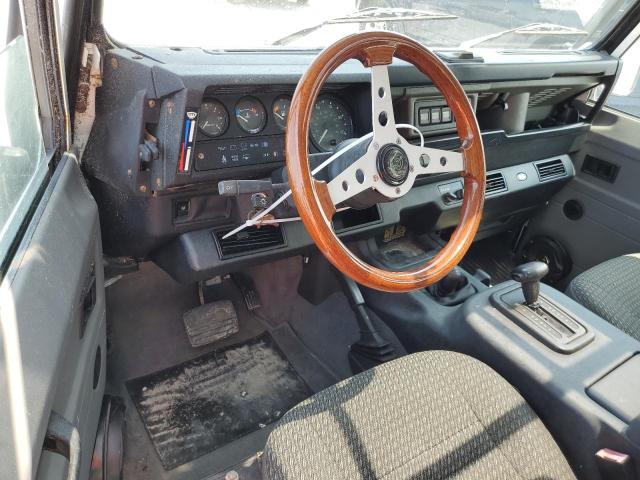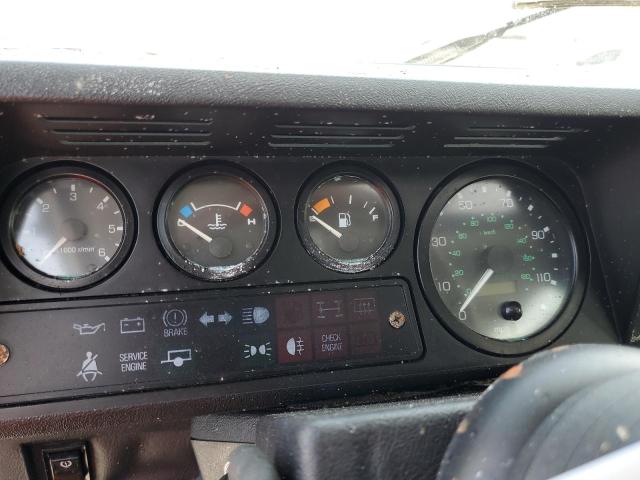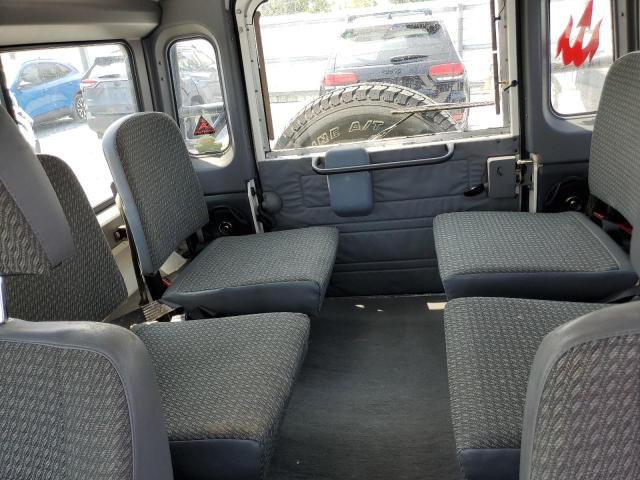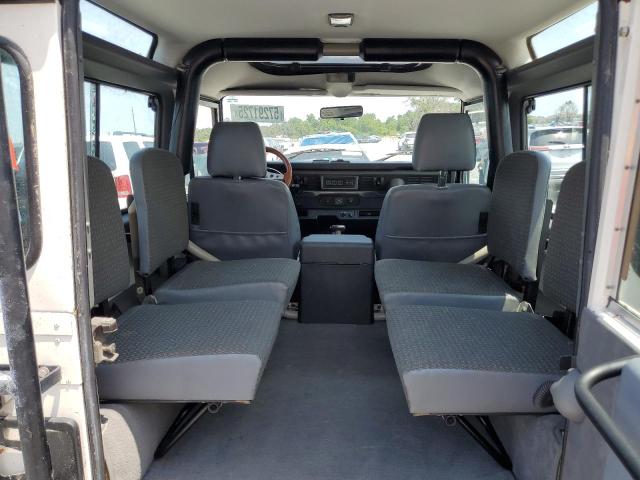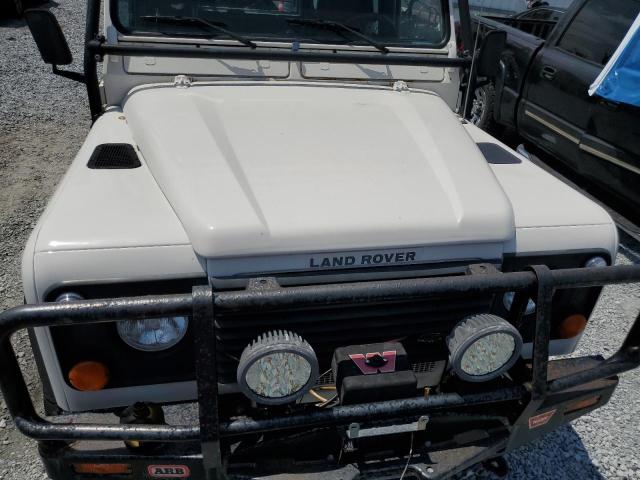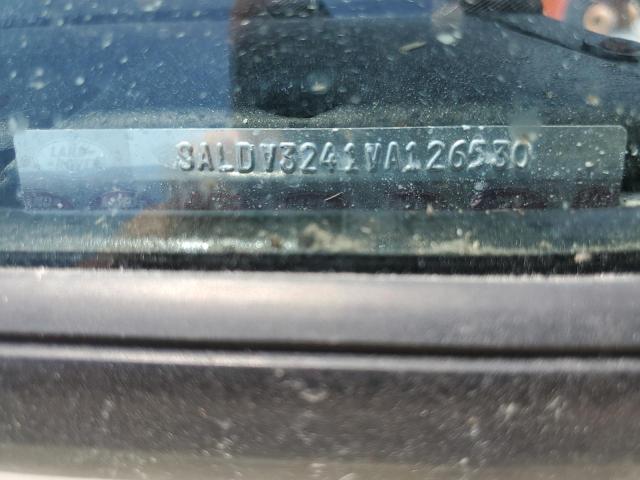1997 LAND ROVER DEFENDER | SALDV3241VA126530
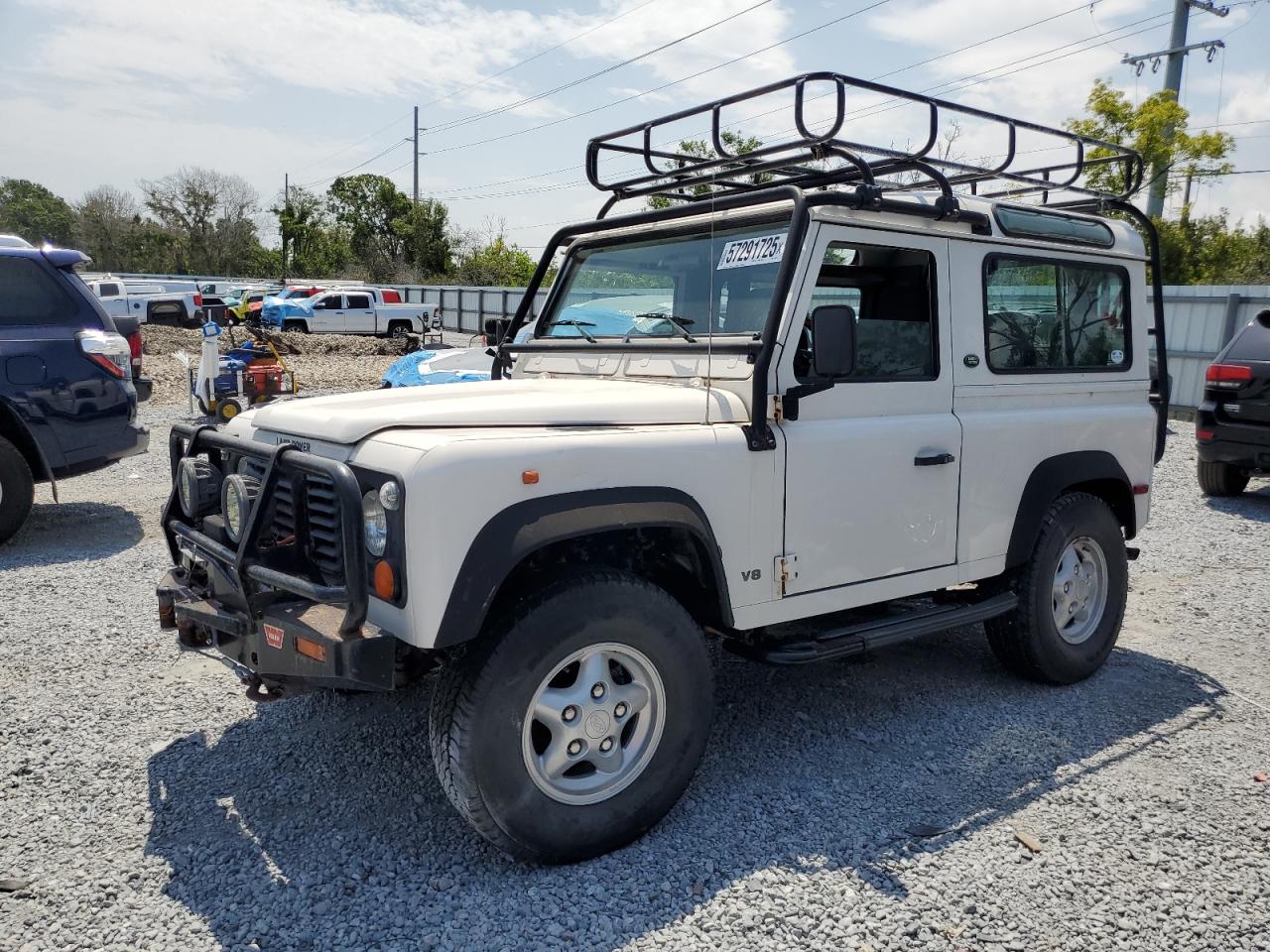 ❯
❯
Specifications
4
~$48,000
Engine: 2.2L turbocharged inline-4 diesel
Torque: 360 Nm
0–100 km/h: ~15.8 s
The Land Rover Defender wasn’t about straight-line performance — it was about going where no other vehicle could go. With a box-section ladder frame chassis, permanent four-wheel drive, two-speed transfer case, and locking center differential, the Defender offered exceptional off-road capability that made it a legend among military, agricultural, and expedition users worldwide.
Although its power outputs were modest — especially in early models — the Defender’s torque-rich diesel engines, particularly the 2.2L Td4 and 2.4L Puma units in later years, provided ample low-end grunt to climb steep gradients, ford deep water, and crawl over rocks. Suspension consisted of coil springs all around (replacing leaf springs from its Series predecessors), delivering better wheel articulation and ground clearance.
Its true "sport" lay in extreme terrain mastery. It could drive up near-vertical slopes, wade through half-meter-deep rivers, and tow over 3 tons. It wasn't fast — but it was unstoppable. And for purists, it remained one of the last truly mechanical off-road vehicles, with manual gearboxes, no traction control, and a full-time connection to the terrain beneath its wheels.
Body Styles
The Land Rover Defender (1990–2016) was offered in an unusually wide range of body types, all unified by a strictly functional, industrial design philosophy. It was based on a ladder-frame chassis and featured non-structural aluminum body panels over a steel frame, giving it immense modularity. The core configurations were the Defender 90, Defender 110, and Defender 130, where the numbers referred approximately to the wheelbase length in inches.
The Defender 90 was a compact, short-wheelbase two-door off-roader, with an upright greenhouse, flat roof, and minimal front and rear overhangs. It featured either a hardtop or station wagon body, with a side-hinged rear door and limited cargo capacity, emphasizing maneuverability in tight spaces and off-road trails. Despite its modest length of around 3.8 meters, its tall stance, square proportions, and exposed hinges gave it immense presence.
The Defender 110, by contrast, was a long-wheelbase four-door utility wagon or pickup that stretched to nearly 4.8 meters in length. It was commonly configured as a station wagon with three rows of seating, making it a rare example of a truly rugged SUV with 3-row capacity. The rear cargo area was large, boxy, and accessed via a wide side-hinged door. Its roofline remained perfectly horizontal from windshield to rear pillar, with large windows offering maximum visibility and vertical side panels simplifying cargo mounting and interior storage.
The Defender 130 was the extended chassis model, designed primarily as a crew cab pickup with a utility tray or flatbed at the rear. It featured a four-door cabin with two full seating rows and an elongated rear overhang to accommodate heavy-duty commercial or expedition gear. With an overall length exceeding 5.2 meters, it was a visual anomaly — long, towering, and unapologetically utilitarian.
All versions shared the same design DNA: squared wheel arches, exposed bolt heads, externally mounted spare wheel, near-vertical windshield, flat side glass, and completely flat roof panels that allowed the mounting of expedition gear, roof tents, or utility racks. The ride height was considerable, with visibly articulated suspension and heavy-duty axles exposed beneath the body. The proportions prioritized function, with zero attempt to streamline the profile. Instead, the silhouette was an unfiltered expression of mechanical honesty — built not to impress, but to survive.
Model Name Meaning (Manufacturer)
“Defender” was introduced in 1990 to differentiate this model from the newly released Discovery, and to align with the military-grade naming theme. The number suffixes (90, 110, 130) refer to approximate wheelbase lengths in inches, a nod to Land Rover’s utilitarian heritage.
Model Name Meaning (Languages)
The word “Defender” conveys protection, strength, and endurance — fitting for a vehicle known for surviving warzones, deserts, and jungles. It has universal recognition and symbolic power, evoking reliability and resilience across languages and cultures.
Body & Interior Colors and Rims
The Land Rover Defender (1990–2016) remained remarkably consistent in its design throughout its production, with its rugged utilitarian ethos reflected in a palette of earth-toned and military-inspired exterior colors. Signature factory finishes included Keswick Green, Santorini Black, Indus Silver, Corris Grey, Firenze Red, and Orkney Grey, with occasional appearances of Tamar Blue, Arles Blue, and Yulong White in special editions. Heritage-focused trims, such as the Defender 90 Heritage Edition, revived classic hues like Grasmere Green with contrasting Alaska White roofs — a direct homage to early Series I Land Rovers.
The Defender’s unpainted black bumpers, exposed rivets, and functional body lines meant that color played a secondary role to durability and identity. However, high-end and commemorative variants — such as the Autobiography, Adventure, and Final Edition models — introduced two-tone combinations, satin or gloss black roof finishes, and color-keyed wheel arches that added a degree of visual flair to the otherwise austere design.
Interiors across most of the Defender’s production span were deliberately sparse, with durability prioritized over luxury. Early models featured vinyl-trimmed seats, bare metal panels, and rubber floor mats, suitable for farming, expedition, or military use. Later variants saw the introduction of cloth upholstery, followed by leather-trimmed heated seats in upscale trims. Interior colors were typically Black, Ebony, or Almond, with dashboard elements kept simple — often in black molded plastic, body-color metal, or matte grey finishes. Top-tier trims like the Autobiography featured contrast-stitched Windsor leather, Alcantara headliners, aluminum gear knobs, and brushed steel door sills, blending old-school form with modern refinement.
Wheels ranged widely depending on trim and intended use. Base models used 16-inch pressed steel wheels, often finished in white or light grey, evoking the Defender’s agricultural roots. Higher trims and special editions were equipped with 5-spoke or sawtooth-style alloy wheels in finishes like Silver Sparkle, Gloss Black, or Dark Anthracite. Some off-road-focused models included beadlock-style wheels, M/T tires, and diamond-cut alloy rims, enhancing capability and appearance.
The Defender’s characteristic stance — high ground clearance, squared-off fenders, and minimal overhangs — made wheel fitment a crucial part of its visual identity. Chunky off-road tires, mud flaps, and raised white-letter sidewalls reinforced the vehicle’s off-road prowess. Even in its most luxurious trims, the Defender never lost the visual language of a working tool — and the wheels and trim options reflected that dual mission.
Top Expensive Options
- Leather Premium Seats with Heated Function: $2,000
- Snorkel and Raised Air Intake Kit: $900
- Roof Rack with Ladder and Expedition Rails: $1,500
- Warn Winch and Front Bumper Mount: $2,500
- Heritage Style Grille and Wheel Set: $1,000
- LED Lighting Conversion Kit: $1,200
- Soundproofing and Carpet Upgrade Kit: $1,300
- Fire & Ice or Autobiography Edition Exterior Package: $3,000+
- Locking Front and Rear Differentials (Aftermarket): $2,000
- Heavy-Duty Off-Road Suspension Upgrade: $1,700
vs Competitors
The Defender was often compared to the Toyota Land Cruiser 70, Jeep Wrangler, and Mercedes G-Class (W463). The Land Cruiser was more durable in harsh climates, the Wrangler more modifiable, and the G-Wagen more luxurious. Yet none matched the Defender's blend of British heritage, mechanical purity, and expedition-ready customization.
It was less comfortable than all of them — noisier, slower, and less refined. But it was easier to repair, more configurable, and often more capable in deep mud, narrow trails, or arid deserts. For many, the Defender wasn’t just a car — it was a partner in survival, and the only vehicle they trusted where roads end.
Fun Fact
When production of the original Defender ended in January 2016, it marked the end of a 68-year lineage tracing back to the 1948 Series I. The last Defender ever built was a Heritage Edition 90 Station Wagon, finished in Grasmere Green, and is now preserved in Land Rover’s official collection. Over its lifetime, more than 2 million units were built, and many are still in daily use on farms, safaris, and expeditions around the world — a testament to its legendary status.
-
Make
-
Model
-
Year1997
-
ACV$32,498
Lot Details
-
Sale Date20/Jun/2025
-
Lot Number57291725
-
Sale document
-
Location
-
Odometer0 miles (0 km)
-
Primary Damage:WATER/FLOOD
-
Fuel
-
Engine Type4.0L 8
-
Transmission
-
Drive Type
-
Color
Final Bid Land Rover Defender (1997)
$22,600
$31,925
$41,250
Specifications
4
~$48,000
Torque:
0–100 km/h:
The Land Rover Defender wasn’t about straight-line performance — it was about going where no other vehicle could go. With a box-section ladder frame chassis, permanent four-wheel drive, two-speed transfer case, and locking center differential, the Defender offered exceptional off-road capability that made it a legend among military, agricultural, and expedition users worldwide.
Although its power outputs were modest — especially in early models — the Defender’s torque-rich diesel engines, particularly the 2.2L Td4 and 2.4L Puma units in later years, provided ample low-end grunt to climb steep gradients, ford deep water, and crawl over rocks. Suspension consisted of coil springs all around (replacing leaf springs from its Series predecessors), delivering better wheel articulation and ground clearance.
Its true "sport" lay in extreme terrain mastery. It could drive up near-vertical slopes, wade through half-meter-deep rivers, and tow over 3 tons. It wasn't fast — but it was unstoppable. And for purists, it remained one of the last truly mechanical off-road vehicles, with manual gearboxes, no traction control, and a full-time connection to the terrain beneath its wheels.
Body Styles
The Land Rover Defender (1990–2016) was offered in an unusually wide range of body types, all unified by a strictly functional, industrial design philosophy. It was based on a ladder-frame chassis and featured non-structural aluminum body panels over a steel frame, giving it immense modularity. The core configurations were the Defender 90, Defender 110, and Defender 130, where the numbers referred approximately to the wheelbase length in inches.
The Defender 90 was a compact, short-wheelbase two-door off-roader, with an upright greenhouse, flat roof, and minimal front and rear overhangs. It featured either a hardtop or station wagon body, with a side-hinged rear door and limited cargo capacity, emphasizing maneuverability in tight spaces and off-road trails. Despite its modest length of around 3.8 meters, its tall stance, square proportions, and exposed hinges gave it immense presence.
The Defender 110, by contrast, was a long-wheelbase four-door utility wagon or pickup that stretched to nearly 4.8 meters in length. It was commonly configured as a station wagon with three rows of seating, making it a rare example of a truly rugged SUV with 3-row capacity. The rear cargo area was large, boxy, and accessed via a wide side-hinged door. Its roofline remained perfectly horizontal from windshield to rear pillar, with large windows offering maximum visibility and vertical side panels simplifying cargo mounting and interior storage.
The Defender 130 was the extended chassis model, designed primarily as a crew cab pickup with a utility tray or flatbed at the rear. It featured a four-door cabin with two full seating rows and an elongated rear overhang to accommodate heavy-duty commercial or expedition gear. With an overall length exceeding 5.2 meters, it was a visual anomaly — long, towering, and unapologetically utilitarian.
All versions shared the same design DNA: squared wheel arches, exposed bolt heads, externally mounted spare wheel, near-vertical windshield, flat side glass, and completely flat roof panels that allowed the mounting of expedition gear, roof tents, or utility racks. The ride height was considerable, with visibly articulated suspension and heavy-duty axles exposed beneath the body. The proportions prioritized function, with zero attempt to streamline the profile. Instead, the silhouette was an unfiltered expression of mechanical honesty — built not to impress, but to survive.
Model Name Meaning (Manufacturer)
“Defender” was introduced in 1990 to differentiate this model from the newly released Discovery, and to align with the military-grade naming theme. The number suffixes (90, 110, 130) refer to approximate wheelbase lengths in inches, a nod to Land Rover’s utilitarian heritage.
Model Name Meaning (Languages)
The word “Defender” conveys protection, strength, and endurance — fitting for a vehicle known for surviving warzones, deserts, and jungles. It has universal recognition and symbolic power, evoking reliability and resilience across languages and cultures.
Body & Interior Colors and Rims
The Land Rover Defender (1990–2016) remained remarkably consistent in its design throughout its production, with its rugged utilitarian ethos reflected in a palette of earth-toned and military-inspired exterior colors. Signature factory finishes included Keswick Green, Santorini Black, Indus Silver, Corris Grey, Firenze Red, and Orkney Grey, with occasional appearances of Tamar Blue, Arles Blue, and Yulong White in special editions. Heritage-focused trims, such as the Defender 90 Heritage Edition, revived classic hues like Grasmere Green with contrasting Alaska White roofs — a direct homage to early Series I Land Rovers.
The Defender’s unpainted black bumpers, exposed rivets, and functional body lines meant that color played a secondary role to durability and identity. However, high-end and commemorative variants — such as the Autobiography, Adventure, and Final Edition models — introduced two-tone combinations, satin or gloss black roof finishes, and color-keyed wheel arches that added a degree of visual flair to the otherwise austere design.
Interiors across most of the Defender’s production span were deliberately sparse, with durability prioritized over luxury. Early models featured vinyl-trimmed seats, bare metal panels, and rubber floor mats, suitable for farming, expedition, or military use. Later variants saw the introduction of cloth upholstery, followed by leather-trimmed heated seats in upscale trims. Interior colors were typically Black, Ebony, or Almond, with dashboard elements kept simple — often in black molded plastic, body-color metal, or matte grey finishes. Top-tier trims like the Autobiography featured contrast-stitched Windsor leather, Alcantara headliners, aluminum gear knobs, and brushed steel door sills, blending old-school form with modern refinement.
Wheels ranged widely depending on trim and intended use. Base models used 16-inch pressed steel wheels, often finished in white or light grey, evoking the Defender’s agricultural roots. Higher trims and special editions were equipped with 5-spoke or sawtooth-style alloy wheels in finishes like Silver Sparkle, Gloss Black, or Dark Anthracite. Some off-road-focused models included beadlock-style wheels, M/T tires, and diamond-cut alloy rims, enhancing capability and appearance.
The Defender’s characteristic stance — high ground clearance, squared-off fenders, and minimal overhangs — made wheel fitment a crucial part of its visual identity. Chunky off-road tires, mud flaps, and raised white-letter sidewalls reinforced the vehicle’s off-road prowess. Even in its most luxurious trims, the Defender never lost the visual language of a working tool — and the wheels and trim options reflected that dual mission.
Top Expensive Options
- Leather Premium Seats with Heated Function: $2,000
- Snorkel and Raised Air Intake Kit: $900
- Roof Rack with Ladder and Expedition Rails: $1,500
- Warn Winch and Front Bumper Mount: $2,500
- Heritage Style Grille and Wheel Set: $1,000
- LED Lighting Conversion Kit: $1,200
- Soundproofing and Carpet Upgrade Kit: $1,300
- Fire & Ice or Autobiography Edition Exterior Package: $3,000+
- Locking Front and Rear Differentials (Aftermarket): $2,000
- Heavy-Duty Off-Road Suspension Upgrade: $1,700
vs Competitors
The Defender was often compared to the Toyota Land Cruiser 70, Jeep Wrangler, and Mercedes G-Class (W463). The Land Cruiser was more durable in harsh climates, the Wrangler more modifiable, and the G-Wagen more luxurious. Yet none matched the Defender's blend of British heritage, mechanical purity, and expedition-ready customization.
It was less comfortable than all of them — noisier, slower, and less refined. But it was easier to repair, more configurable, and often more capable in deep mud, narrow trails, or arid deserts. For many, the Defender wasn’t just a car — it was a partner in survival, and the only vehicle they trusted where roads end.
Fun Fact
When production of the original Defender ended in January 2016, it marked the end of a 68-year lineage tracing back to the 1948 Series I. The last Defender ever built was a Heritage Edition 90 Station Wagon, finished in Grasmere Green, and is now preserved in Land Rover’s official collection. Over its lifetime, more than 2 million units were built, and many are still in daily use on farms, safaris, and expeditions around the world — a testament to its legendary status.

